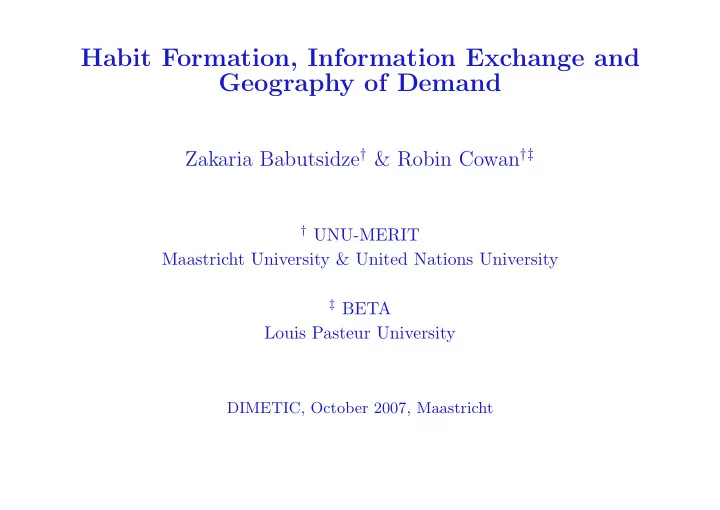

Habit Formation, Information Exchange and Geography of Demand Zakaria Babutsidze † & Robin Cowan †‡ † UNU-MERIT Maastricht University & United Nations University ‡ BETA Louis Pasteur University DIMETIC, October 2007, Maastricht
agenda 1. motivation 2. literature 3. model 4. results 5. simulations 6. conclusions Habit Formation, Information Exchange and Geography of Demand 2/12
motivation • consumer behavior – heterogeneity – interactions – propagation of knowledge/information • implications for the geography of demand Habit Formation, Information Exchange and Geography of Demand 3/12
main components • modeling dynamics of the utilities of a single good for a single consumer • main components: (i) interdependency among consumers & (ii) inertia • two interpretations – 1 st : (i) information exchange & (ii) tendency to consume the familiar good – 2 nd : (i) network effects & (ii) habit formation Habit Formation, Information Exchange and Geography of Demand 4/12
literature • geography of demand (on services): Wang & Graham (98), Hudman & Jackson (02) • imperfect information: Nelson (70), Samuelson (04) • local (non-market) interactions: Eshel et al. (98), Glaiser & Scheinkman (00) • network effects: Cowan et al. (97), Cowan et al. (04) • habit formation: Deusenberry (49), Abel (90) Habit Formation, Information Exchange and Geography of Demand 5/12
model i: full specification • many consumers (on the line/circle) • many substitute goods (with equal prices) • social network: fixed neighborhood (on the line/circle) • discrete choice: consumer s buys one unit of one good n every period t and derives utility u s n ; t • utility: u s n ; t = i s n ; t + e s n ; t • dynamics: 8 if n = ¯ ζ n di s < – inherent (habit formation): dt = n 0 otherwise : de s µ ( u j n − u s dt = P – network (information exchange): n ) n j Habit Formation, Information Exchange and Geography of Demand 6/12
model ii: modified • only two goods • only two neighbors • problem: habit formation u s di s • solution: probabilistic choice P s dt = αu s n = n n j ⇒ n u s P j ∈ N • result: du s dt = αu s 1 1 + µ ( u s +1 + u s − 1 − 2 u s 1 ) 1 1 du s dt = αu s 2 + µ ( u s +1 + u s − 1 − 2 u s 2 2 ) 2 2 • or dy s dt = αy s + µ y s +1 + y s − 1 − 2 y s ´ ` where y s = u s 1 − u s 2 . Habit Formation, Information Exchange and Geography of Demand 7/12
model iii: analytic solution • using Turing (52) and Childress (05) • Taylor expansions around agent s • continuous time and space • partial differential equation: µ∂ 2 y ∂y ∂t = αy + ˜ ∂s 2 • solution: „ « k 2 π y = e σt cos S s y 0 where σ = α − µk 2 4 π 2 S 2 and k is a positive integer. Habit Formation, Information Exchange and Geography of Demand 8/12
results Remember: σ = α − µk 2 4 π 2 S 2 comparative statics • current parameters ∂σ – habit formation rate: ∂α > 0 ∂σ – information exchange rate: ∂µ < 0 ∂σ – number of agents: ∂S > 0 • putting back neighborhood size and number of goods ∂σ – neighborhood size: ∂H < 0 ∂σ – number of goods: ∂N = 0 Habit Formation, Information Exchange and Geography of Demand 9/12
simulations i: modified model 500 400 8 6 300 Time 4 200 2 100 0 0 0 20 40 60 80 100 Agent Figure 1: Good purchases in the simulation of modified model Habit Formation, Information Exchange and Geography of Demand 10/12
simulations ii: full model 500 400 8 6 300 Time 4 200 2 100 0 0 0 20 40 60 80 100 Agent Figure 2: Good purchases in the simulation of full model Habit Formation, Information Exchange and Geography of Demand 11/12
conclusions • information spillovers from geographically fixed social networks do affect the geography of demand • interplay of social (information exchange) and individual (inertia) forces generate rich dynamics for the single goods on the market • this kind off behavior generates the clustering in demand: some geographic neighborhoods collectively prefer one good over another, while other neighborhoods do exactly the opposite. • depending on the characteristics of the society, the clustering pattern can be short-run or long-run. Habit Formation, Information Exchange and Geography of Demand 12/12
Recommend
More recommend